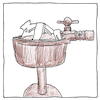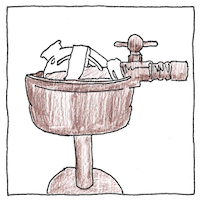Crawford Long,
Horace Wells,
William T. G. Morton
medicine

|
Anesthesia
Many produced forms of anesthesia with primitive means, including alcohol, herbs, and alkaloids. Early Arab surgeons mixed opium with poisons from mandrake, hemlock, ivy, and other stuff. Hugh of Lucca and his son Theodoric used similar mixtures as an inhaled anesthetic in the thirteenth century. People enjoyed ether and nitrous oxide gases recreationally long before they were used to produce anesthesia. Doctors and dentists in the United States were the first to operate with patients under ether or nitrous oxide. Crawford Long excised two small tumors from the neck of James Venable under ether, without pain, in 1842. Horace Wells made the first public demonstration operating with the patient under nitrous oxide in 1845, and the dentist William T. G. Morton demonstrated painless surgery using diethyl ether in 1846, whereupon Oliver Wendell Holmes Senior named the procedure an anesthetic and the state that it produced anesthesia.
Theories of action
For many years, erroneous theories of how general anesthetics work have persisted because scientists didn’t know how nerve cells work. One modern theory depends on mechanistic and thermodynamic models of how the drug interacts with lipid layers and ion channels of nerve cells. Another theory asserts that the drugs inhibit luciferase proteins in the ion channels; however, anaesthetic-protein interactions remain mysterious.
Cartoon anesthetics
Shock is an anesthetic, or at least that’s one way to explain it, even though it’s useless as a medical procedure. So is a great blow on the skull with a rubber hammer. Early doctors, tempted by the simplicity of the rubber hammer procedure, didn’t understand its long-term effects. Similar to the offer in jest to help with the pain of a broken wrist by smashing the opposite thumb with a hammer. Pain is a complex issue, but not for opponents in video games, not for puppets, and not for characters in cartoons.



Subject of many dental procedures, due to pain-free dentistry, I have become focused on the needle that delivers the novocaine.
Anesthetics preceded antiseptics, which were not established until after 1854 when John Snow showed that cholera was carried by contaminated water, and after 1860, when Louis Pasteur pointed out that micro-organisms were responsible for infections.
See also in The book of science:
Readings in wikipedia: